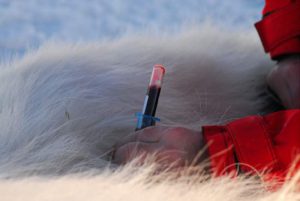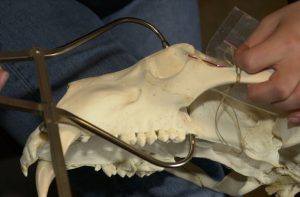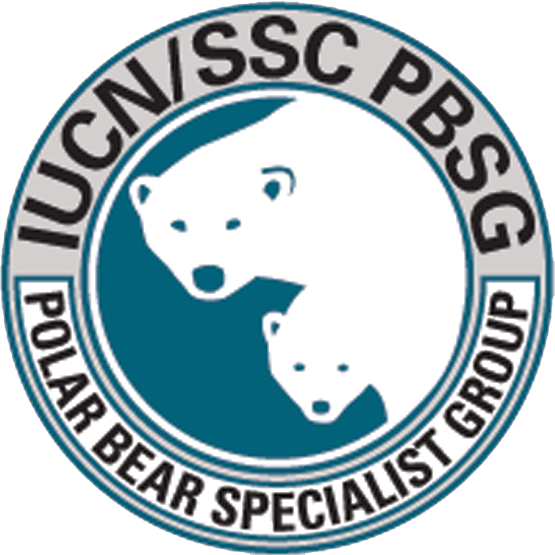As Inuit are dependent on food from the Arctic marine biota and these have shown high loads of contaminant, this field has been extensively studied for contaminant loads and the effect of these. Heavy metals are often studied in muscle, liver, and kidney and for mercury (Hg) as well in hair and blood. Persistent organic pollutants (POPs) are generally studied in adipose tissue or blood. Effect studies on live polar bears are restricted to external examination and blood, whereas access to polar bear from the traditional Inuit hunt allows for examination of sexual organs, internal organs, and bone composition.
Pollution Observation
Credit: Andrew Derocher
Age Determination
Both contaminant studies and effect studies are very dependant on a precise age determination. The ages of the bears were estimated by counting annual layering in decalcified thin sections (14 μm) stained in toluidine blue in the cementum of the canine or premolar tooth, as described by Dietz et al. (1991).
Heavy Metals
Mercury analyses were performed using hydride generation and the amalgam technique, as described by e.g. Dietz et al. (1995, 2000, 2006). Cadmium in tissue samples are, in general, analysed using a flame atomic absorption spectrophotometer (AAS, Perkin-Elmer 3030), or the graphite furnace technique Perkin-Elmer 3030 with Zeeman background correction at lower concentrations This latter technique was also used for selenium analyses (Dietz et al. 2000). Zinc analyses were carried out by flame AAS Perkin-Elmer 3030. For screening of other elements, the ICPMS technique can be used.
Persistent Organic Pollutants (POPs)

Blood from from tagged polar bears is an important media to study the effects of contaminants. Credit: Rune Dietz
Analysis of POPs (organochlorines and brominated flame retardants) analysis in adipose and blood plasma of polar bears has been investigated according to methods described in detail by e.g. Dietz et al., 2004, 2007, Gebbink et al., 2008a, 2008b, Muir et al., 2006, Verreault et al., 2005, 2008 (see summary of results in contaminant section). A wide variety of contaminants are often analysed including: PCBs; up to 61 congeners, OCs; 1,2,4,5-tetrachlorobenzene (TeClBz), pentachlorobenzene (PnClBz), heaxchlorobenzene (HCB), α-hexachlorocyclohexane (HCH), β-HCH, γ-HCH, octachlorostyrene (OCS), the chlordanes and metabolites heptachlor epoxide, oxychlordane, trans-chlordane, cis-chlordane, trans-nonachlor, cis-nonachlor, p,p’-DDE, p,p’-DDD, p,p’-DDT, dieldrin, photomirex, mirex and tris(4-chlorophenyl)methane (TCPM). Also in fat, 35 PBDEs are being monitored for (BDE-17, -25, -28, -54, -47, -49, -66, -77, -100, -119, -99, -116, -85, -155, -154, -153, -139, -138, -140, -180, -183, -184, -191, -187, -190, -171, -202, -201, -197, -203, -196, -207, -208, -206 and -209), as well as several other BFRs including 2,2,’,4,4’,5-pentabromobiphenyl (BB-101), 2,2’,4,4’,5,5’-hexaBB (BB-153), pentabromotoluene (PBT), hexabromobenzene (HBB), total-(α)-hexabromocyclododecane (HBCD), bis(2,4,6-tribromophenoxy)ethane (BTBPE) and pentabromoethylbenzene (PBEB). In other investigations the metabolites have been investigated as these may be more toxic to the polar bears (e.g. Verreault et al. 2005, Gebbink et al. 2008a, 2008b). Little information is available on polar bears, Dioxins, Furans and non-ortho PCBs (for methods see Riget et al. 2005).
Perfluoroalkyl Contaminants (PFCs)
PFCs is in general investigated in the liver using the extraction method based on ion pairing as described by e.g. Bossi et al. (2005a, 2005b), Smithwick et al. (2005a, 2005b) and Dietz et al (200). 13C2-PFDA and 13C4-PFOS were used as surrogate standards. Instrumental analysis was performed by liquid chromatography-tandem mass spectrometry (LC-MS-MS) with electrospray ionization (ESI). The extracts (20 μL injection volume) were chromatographed on a C18 Betasil column (2.1 50 mm, Thermo Hypesil-Keystone, Bellafonte, PA) using an Agilent 1100 Series HPLC (Agilent Technologies, Palo Alto, CA). The HPLC is often interfaced to a triple quadrupole API 2000 (Sciex, Concorde, Ontario, Canada) equipped with a TurboIon Spray source operating in negative ion mode. Instrument set-up, quality assurance and calibration procedures as well as the standards and reagents used are described in detail by Bossi et al. (2005).
Effects of Contaminants on Polar Bear Brains
Recently effort has been addressed towards investigating the effects of contaminants on brain biomarkers in polar bear such as N-methyl-D-aspartate (NMDA), dopamine-2, gamma-aminobutyric acid type A, muscarinic cholinergic, and nicotinic cholinergic receptors; cholinesterase and monoamine oxidase enzymes). Similar studies have revealed negative effects on other wildlife species with high Hg burdens (Basu et al 2005a, 2005b, 2009).
Osteodensitometry - A Measure of Osteoporosis
X-ray osteodensitometry is applied to detect osteopenia (osteoporosis) by use of a Norland XR 26 X-ray bone densitometer which determines the bone mineral density (calcium-phosphate; hydroxyapatite) during a dual X-ray absorptiometry (DXA). Skulls are scanned in Research mode (speed: 60 mm/sec; resolution: 3.0 x 3.0 mm; width: 24.9 cm) and analysed in XR software revision 2.4®, which generate a picture of the bone segment and calculate bone mineral density of hydroxyapatite (BMD; g cm-2). To ensure that skull BMD represent the mineral status of the skeletal system in general, measurement of femur and vertebrae BMD is also conducted showing a high correlation. The DXA-scanner is daily calibrated using a phantom with known mineral density. In addition, the precision is tested by a 10 time rescanning (mean=521.96 g cm-2, SD=0.60) which from the formula [1 – (SD/mean) x 100%] gives a precision of 99.88%. Fragmentation and loss of teeth material caused by handling and lead shot is not a problem.
Histology
Tissues are trimmed, processed conventionally, embedded in paraffin, sectioned at about 4 μm and stained with haematoxylineosin (HE) for routine diagnostics. Periodic acid-schiff (PAS) and periodic acid silver methenamine (PAS-M) are used to demonstrate glomerular (capillary and mesangial) and tubular changes; Van Gieson and Masson Trichrome to detect fibrous tissue (collagen) in the glomeruli (glomerulofibrosis) and in the interstitium (interstitial fibrosis); and Smorl and Perls’ prussian blue reaction to detect lipofuscin and haemosiderin pigments, respectively. Glomerular, tubular and interstitial lesions are evaluated semi-quantitatively by examinating the renal tissue in 10 randomly selected low to high power fields (5-40x magnification). Based on these observations, the lesions were graded into one of 3 groups (0: absent, 1: mild and 2: moderate).
Skull - Size, Assymetry and Pathology

Polar bear brain biometric measurements. Credit: Christian Sonne
In order to describe size and growth, nine metric traits are measured on the right side of each skull using digital callipers (Mitutoyo, Mitutoyo Corporation, Japan) to the nearest 0.04 mm. Traits are measured twice on each skull, always by the same person, and never twice on the same day. Many skulls are and thus the entire range of measurements cannot be performed on all skulls. The average of the two measurements were used in all further analyses ((measurement1right + measurement2right)/2). Fourteen meristic foramina traits are registered and defined by minimum inner diameter size, depending on skull site. Blunt metal pins are used to determine whether the size of the individual foramen fell within the predetermined accepted range. Observed foramina meeting the set criteria are counted on the right (R) and left (L) side of each skull. The foramina are only registered once per skull, except for a randomly chosen subsample of 61 skulls which is registered twice, in order to determine the measurement (registration) error. All registrations are conducted by the same person, and the subsample registration was done on a separate day from the rest. In addition, nine metric bilateral traits are measured in order to estimate the level of FA in the skulls. Each trait is measured on the right and left side of each skull, using digital callipers (Mitutoyo, Mitutoyo Corporation, Japan) to the nearest 0.04 mm. The traits are measured twice on each skull, always by the same person, and never twice on the same day. Skulls are examined for pathology and 7 different pathological changes are described (tooth wear, periodontitis including alveolar bone loss, adonti, tooth displacement, caries, osseous proliferations and exostosis). The prevalence of tooth breakage is often close to zero and therefore included as wear (it is often not possible to separate wear and breakage). However, only tooth wear and periodontitis prevalence often allow for quantitatively data analyses. Skulls are categorized into four groups according to the degree of tooth wear and periodontitis.
Sexual Organs - Size and Morphology
Testes length and weight is recorded as an average of left and right testes before the tissue are trimmed, processed conventionally, embedded in paraffin, sectioned at about 4 μm and stained with Haematoxylin (Al-Haematein)-Eosin (HE) for routine diagnostics. In males, all slides are examinated consecutively from seminiferous tubules to the caput of epididymidis. The maximal diameter (µm) of 5 randomly chosen seminiferous and epididymal tubules is measured as well despite in individuals with immature closure and/or suboptimal fixation. The presence of elongated spermatids, spermatozoa and fibrosis/atrophy/hyalinisation/inflammation of seminiferous tubules and interstitium is recorded together with the sperm morphology in the individuals exhibiting accumulation of these in the epididymal. Penis and baculum are investigated macroscopically for gross pathology before recording of weight and length and X-ray osteodensitometry is also applied to all bacula for detecting osteoporosis. In females, dimensions of clitoris, uterine corpus (diameter) and each uterine horn (diameter at mid-point and length) and ovaries (length, weight) are measured. Data are given as the average values of the measurement of the left and right organs. Each ovary is sliced longitudinally in four sections. The number of follicles in four size categories (<1 mm; 1-2 mm; 2-3 mm and 3-6 mm) are counted macroscopically in each section. For summary statistics an average of the number from 4 longitudinal sections is used. The presence of corpus luteum is detected and histology is conducted as described above.
Further Reading
- Bancroft JD, and Stevens A.1996. Theory and Practice of Histological Techniques. Churchill Livingstone, New York.
- Basu N, Klenavic K, Gamberg M, O’Brien M, Evans RD, Scheuhammer AM, and Chan HM. 2005a. Effects of mercury on neurochemical receptor binding characteristics in wild mink. Environmental Toxicology and Chemistry 24: 1444-1450.
- Basu N, Scheuhammer AM, Grochowina NM, Klenavic K, Evans RD, O’Brien M, and Chan HM. 2005b. Effects of mercury on neurochemical receptors in wild river otters (Lontra canadensis). Environmental Science & Technology 39: 3585-3591.
- Basu N, Scheuhammer AM, Sonne C, Letcher RJ, Born EW, and Dietz R. 2009. Is dietary mercury of neurotoxicological concern to wild polar bears (Ursus maritimus). Environmental Toxicology and Chemistry 28: 133-140.
- Bechshøft TØ, Rigét FF, Sonne C, Wiig Ø, Dietz R, and Letcher RJ. 2009. Skull foramina asymmetry in East Greenland and Svalbard polar bears (Ursus maritimus) in relation to stressful environments. Annales Zoologici Fennici 46: 181-192.
- Bechshøft TØ, Rigét FF, Wiig Ø, and Sonne C. 2008b. Fluctuating asymmetry in metric traits; a practical example of calculating asymmetry, measurement error and repeatability. Annales Zoologici Fennici 45: 32-38.
- Bechshøft TØ, Sonne C, Rigét FF, Wiig Ø, and Dietz R. 2008c. Skull growth, size and sexual dimorphism in East Greenland and Svalbard polar bears (Ursus maritimus). Polar Biology 31: 945-958.
- Bechshøft TØ, Wiig Ø, Sonne C, Rigét FF, Dietz R, Letcher RJ, and Muir DCG. 2008a. Temporal and spatial variation in metric asymmetry in skulls of polar bears (Ursus maritimus) from East Greenland and Svalbard. Annales Zoologici Fennici 45: 15-31.
- Bossi R, Riget FF, Dietz R, Sonne C, Fauser P, Dam M, and Vorkamp K. 2005a. Preliminary screening of Perfluoroctanate (PFOS) in fish, mammals and birds from Greenland and Faroe Islands. Environmental Pollution 136: 323-329.
- Bossi R, Riget FF, and Dietz R. 2005b. Temporal and spatial trends of perflourinated compounds in ringed seal (Phoca hispida) from Greenland. Environmental Science & Technology 39: 7416-7422.
- Dietz R, Riget F, and Born EW. 2000b. Geographical differences of zinc, cadmium, mercury and selenium in polar bears (Ursus maritimus) from Greenland. The Science of the Total Environment 245: 25-48.
- Dietz R, Nielsen CO, Hansen MM, and Hansen CT. 1990. Organic mercury in Greenland birds and mammals. The Science of the Total Environment 95: 41-51.
- Dietz R, Born EW, Agger CT, and Nielsen CO. 1995a. Zinc, cadmium, mercury, and selenium in polar bears (Ursus maritimus) from East Greenland. Polar Biology 15: 175-185.
- Dietz R, Riget F, Sonne C, Muir DCG, Backus S, Born EW, Kirkegaard M, and Letcher RJ. 2007. Age and seasonal variability of polybrominated diphenyl ethers in free-ranging East Greenland polar bears (Ursus maritimus). Environmental Pollution 146: 177-184.
- Dietz R, Riget F, Born EW, Sonne C, Grandjean P, Kirkegaard M, Olsen MT, Asmund G, Baagøe H, and Andreasen C. 2006. Trends in mercury in hair from Greenland polar bears (Ursus maritimus) during 1892-2001. Environmental Science & Technology 40: 1120-1125.
- Dietz R, Heide-Jørgensen M-P, Teilmann J, Valentin N, and Härkönen T. 1991. Age determination in European harbour seals Phoca vitulina L. Sarsia 76: 17-21.
- Dietz R, Bossi R, Riget FF, Sonne C, and Born EW. 2008. Increasing perfluorinated acids in East Greenland polar bears (Ursus maritimus) – a new toxic threat to the Arctic bears. Environmental Science & Technology 42: 2701-2707.
- Gebbink WA, Sonne C, Dietz R, Kirkegaard M, Born EW, Muir DCG, and Letcher RJ. 2008b. Target tissue selectivity and burdens of diverse classes of brominated and chlorinated contaminants in polar bears (Ursus maritimus) from East Greenland. Environmental Science & Technology 42: 752-759.
- Gebbink WA, Sonne C, Dietz R, Kirkegaard M, Riget FF, Born EW, Muir DCG, and Letcher RJ. 2008a. Tissue-specific congener composition of organohalogen and metabolite contaminants in East Greenland polar bears (Ursus maritimus). Environmental Pollution 152: 621-629.
- Lyon H, Andersen AP, Hasselager E, Høyer PE, Møller M, Prentø Van Deurs B. 1991. Theory and Strategy in Histochemistry, 1st ed. Springer Verlag, Berlin.
- Muir DCG, Backus S, Derocher AE, Dietz R, Evans TJ, Gabrielsen GW, Nagy J, Norstrom RJ, Sonne C, Stirling I, Taylor MK, and Letcher RJ. 2006. Brominated flame retardants in polar bears (Ursus maritimus) from Alaska, the Canadian Arctic, East Greenland, and Svalbard. Environmental Science & Technology 40: 449-455.
- Riget F, Vikelsøe J, and Dietz R. 2005. Levels and temporal trends of PCDD/PCDFs and non-ortho PCBs in ringed seals from East Greenland. Marine Pollution Bulletin 50: 1523-1529.
- Sandala GM, Sonne C, Dietz R, Muir DCG, Valters K, Bennett ER, Born EW, and Letcher RJ. 2004. Hydroxylated and methyl sulfone PCB metabolites in adipose and whole blood of polar bear (Ursus maritimus) from East Greenland. The Science of the Total Environment 331: 125-141.
- Schandorff S. 1997. Developmental stability and skull lesions in the harbour seal (Phoca vitulina) in the 19th and 20th centuries. Annales Zoologici Fennici 34: 151-166.
- Schandorff S. 1997. Developmental stability and the harbour seal epizootic in 1998. Annales Zoologici Fennici 34: 167-175.
- Smithwick M, Muir DCG, Mabury SA, Solomon K, Martin JW, Sonne C, Born EW, Dietz R, Derocher AE, Evans T, Gabrielsen GW, Nagy J, Stirling I, and Taylor MK. 2005b. A circumpolar study of perfluoroalkyl contaminants in polar bear hepatic tissue (Ursus maritimus). The Science of the Total Environment 39: 5517-5523.
- Smithwick M, Muir DCG, Mabury SA, Solomon K, Martin JW, Sonne C, Born EW, Letcher R, and Dietz R. 2005a: Perfluorinated acids in hepatic tissue from East Greenland polar bears (Ursus maritimus) 1999-2001. Environmental Toxicology and Chemistry 24: 981-986.
- Sonne C, Bossi R, Dietz R, Leifsson PS, Rigét FF, and Born EW. 2008a. The potential correlation between perfluorinated acids and liver morphology in East Greenland polar bears (Ursus maritimus). Toxicological & Environmental Chemistry 90: 275-283.
- Sonne C, Dietz R, Born EW, Rigét FF, Kirkegaard M, Hyldstrup L, Letcher RJ, and Muir DCG. 2004. Is bone mineral composition disrupted by organochlorines in East Greenland polar bears (Ursus maritimus)? Environmental Health Perspectives 112: 1711-1716.
- Sonne C, Dietz R, Born EW, Rigét FF, Leifsson PS, Bechshøft TØ, and Kirkegaard M. 2007b. Spatial and temporal variation in size of polar bear (Ursus maritimus) sexual organs and its use in pollution and climate change studies. The Science of the Total Environment 387: 237-246.
- Sonne C, Dietz R, Leifsson PS, Asmund G, Born EW, and Kirkegaard M. 2007. Are liver and renal lesions in East Greenland polar bears (Ursus maritimus) associated with high mercury levels? Environmental Health 6: 11.
- Sonne C, Dietz R, Leifsson PS, Born EW, Kirkegaard M, Letcher RJ, Muir DCG, Rigét FF, and Hyldstrup L. 2006b. Are organohalogen contaminants a co-factor in the development of renal lesions in East Greenland polar bears (Ursus maritimus)? Environmental Toxicology and Chemistry 25: 1551-1557.
- Sonne C, Dietz R, Leifsson PS, Born EW, Kirkegaard M, Rigét FF, Letcher RJ, Muir DCG, and Hyldstrup L. 2005a. Do organohalogen contaminants contribute to liver histopathology in East Greenland polar bears (Ursus maritimus)? Environmental Health Perspectives 113: 1569-1574.
- Sonne C, Leifsson PS, Dietz R, Born EW, Letcher RJ, Hyldstrup L, Rigét FF, Kirkegaard M, and Muir DCG. 2006a. Xenoendocrine pollutants may reduce size of sexual organs in East Greenland polar bears (Ursus maritimus). Environmental Science & Technology 40: 5668-5674.
- Sonne C, Rigét FF, Dietz R, Kirkegaard M, Born EW, Letcher RJ, Muir DCG. 2005c. Trends in fluctuating asymmetry in East Greenland polar bears (Ursus maritimus) from 1892 to 2002 in relation to organohalogen pollution. The Science of the Total Environment 341: 81-96.
- Sonne C, Rigét FF, Dietz R, Wiig Ø, Kirkegaard M, and Born EW. 2007e. Gross skull pathology in East Greenland and Svalbard polar bears (Ursus maritimus) during 1892 to 2002 in relation to organohalogen pollution. The Science of the Total Environment 372: 554-561.
- Sonne C, Leifsson PS, Dietz R, Born EW, Letcher RJ, Kirkegaard M, Muir DCG, Andersen LW, Rigét FF, and Hyldstrup L. 2005. Enlarged clitoris in wild polar bears (Ursus maritimus) can be misdiagnosed as pseudohermaphroditism. The Science of the Total Environment 337: 45-58.
- Verreault J, Muir DCG, Norstrom RJ, Stirling I, Fisk AT, Gabrielsen GW, Derocher AE, Evans TJ, Dietz R, Sonne C, Sandala GM, Gebbink W, Riget FF, Born EW, Taylor MK, Nagy J, and Letcher RJ. 2005. Chlorinated hydrocarbon contaminants and metabolites in polar bears (Ursus maritimus) from Alaska, Canada, East Greenland, and Svalbard: 1996-2002. The Science of the Total Environment 351-352: 369-390.
- Wiig Ø, Derocher AE, Cronin MM, Skaare JU. 1998. Female pseudohermaphrodite polar bears at Svalbard. Journal of Wildlife Diseases 34: 792-796.
